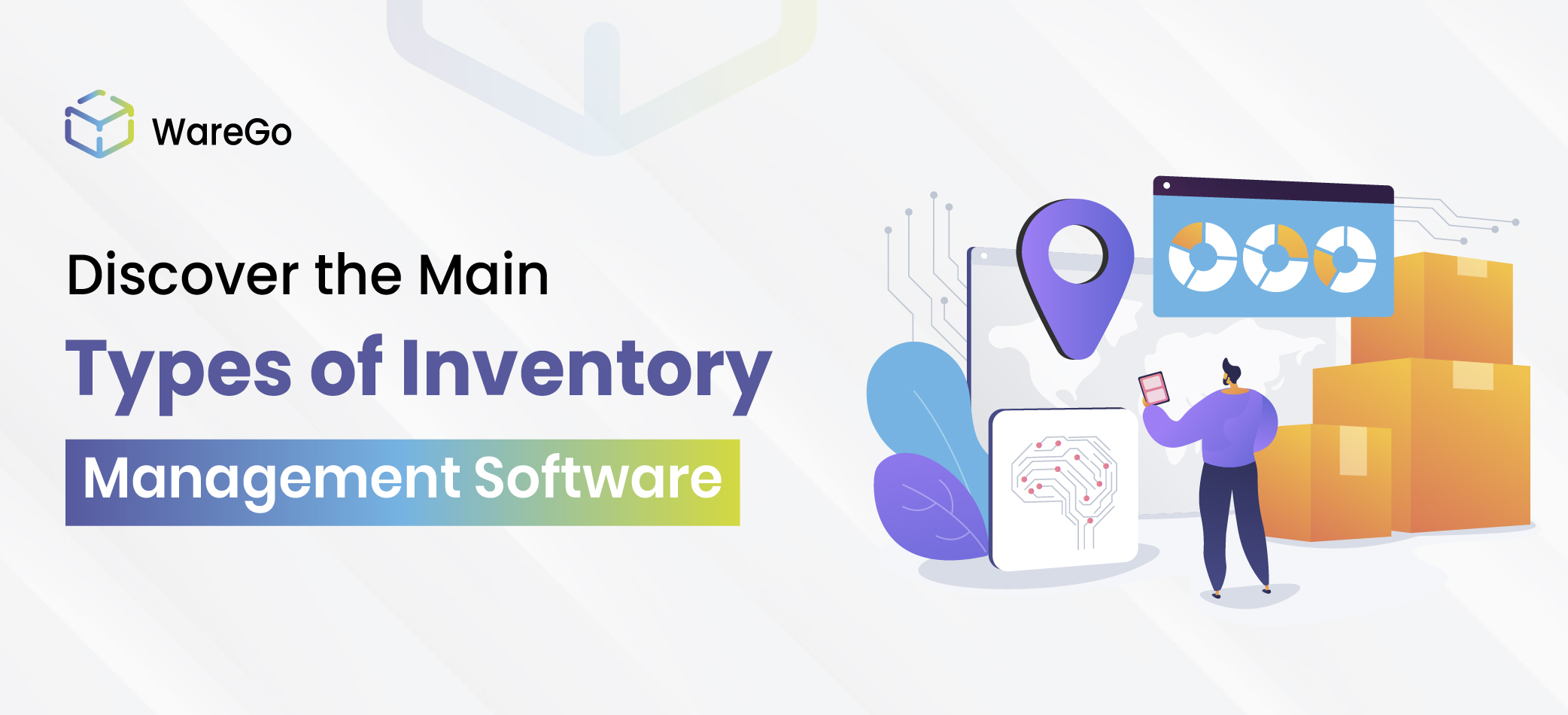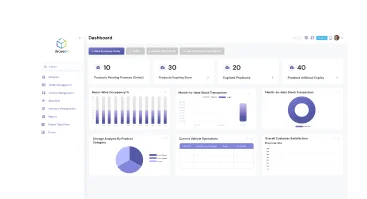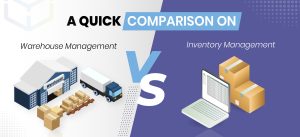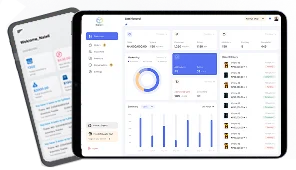
Here is all you need to know about the various types of inventory system that are in widespread use. Find out what they can do for you and which one you need.
Table of Contents
Inventory Software Definition
Inventory management software refers to a system that helps you simplify inventory control.
It does this via different tools. A robust system provides real-time inventory tracking so you have accurate and updated stock information at your fingertips to make better decisions.
Automation tools for key processes like stock replenishment ensure that stockouts are eliminated. AI-powered forecasts help you maintain optimal inventory so that overstocking and high carrying costs are greatly reduced.
With these and other sophisticated tools, the system:
- Provides updated and accurate stock information
- Significantly reduces human errors
- Enhances inventory velocity and turnover
- Maximizes storage space utilization
Given these and many other advantages, a cutting-edge inventory system is vital for businesses of all sizes, from small retailers to major manufacturers.
Get your free demo to see our cutting-edge platform live in action.
Start My FREE Demo!Main Types of Inventory Systems
Inventory systems may be categorized according to their functionality. Based on this, here are the main types of inventory systems to consider.
Barcode Inventory Systems
Barcode inventory software is a highly popular method of tracking inventory using barcode scanning technology. On the other hand, RFID inventory tracking is comparatively more advanced and convenient than barcode scanning. Both methods find extensive use as proven technologies for expediting order fulfillment and warehouse operations.
Although both of these technologies have a similar basic objective, they do serve different business requirements using different methods.
Barcode inventory software is older but quite reliable and cost-effective, too. This technique involves giving a different barcode to each inventory item. You can print this barcode either on labels (which are then attached to the item) or on the item packaging itself.
The barcode is read with the help of handheld barcode scanners and even mobile gadgets. Each time a barcode is scanned, the data acquired is thus sent to the database for instant inventory updates.
This approach is low-cost, simple, and reliable. Hence, it aligns quite well with the needs of small to mid-sized businesses that need an affordable solution for managing their complex inventory.
Another key advantage of this approach is that it integrates easily with both on-premise and cloud-native inventory platforms since it is a mature and simple technology. As a result, this approach allows for greater flexibility since its users can opt for either cloud or on-premise inventory system solutions.
RFID Inventory Systems
RFID inventory tracking works with the help of specialized tags that can wirelessly transmit information. This technology is more convenient since it does not require direct scanning at close distances, unlike barcodes, to input inventory data. Hence, RFID tech allows users to handle multiple items at the same time from a distance.
Besides making the scanning process more convenient and effortless, RFID also speeds up item scanning. Hence, RFID is ideal for large and high-throughput warehouses, distribution centers, and logistics hubs that must process a huge number of items each hour. This system is ideally suited for effortlessly tracking inventory in real-time, very quickly, with less effort. Hence, for organizations that can afford it, this system is the right fit as it significantly boosts productivity. With RFID, complex and busy supply chains can operate with exceptional efficiency.
Given their unique benefits and use cases, sophisticated inventory solutions often support both. Barcode inventory software is ideal for small businesses that prioritize ease of use, affordability, and simple integration.
RFID serves operational objectives of larger enterprises that require real-time inventory data, holistic visibility, and high productivity.
Premium inventory management solutions like WareGo support both RFID and barcode scanning, so you are free to choose the technology that best serves your operational objectives.
Multichannel Inventory Management System
Online entrepreneurs can make good use of the multichannel inventory system to update, process, and automate inventory data across multiple sales platforms with ease and precision.
A key benefit that this system offers is that it can automatically update stock levels with each inventory transaction, such as customer orders, stock purchases, and customer returns. Not just that, it can issue low stock alerts and notifications when inventory becomes critically low. In fact, a capable system can even reorder stock automatically and thus replenish stock with minimal human intervention. Hence, the system reduces the risk of stockouts, overselling, and costly human errors that can negatively impact customer satisfaction, besides causing significant losses.
E-commerce businesses of all stripes often need strong integration for all kinds of e-commerce platforms, fulfillment services, shopping carts, and marketplaces. Hence, they rely strongly on e-commerce inventory systems to sync real-time inventory data with these business tools. Doing so allows operations to proceed seamlessly, greatly increases accuracy, and boosts customer experience.
Multichannel inventory management works by simultaneously syncing inventory data with all online channels. So no matter how many e-commerce platforms and marketplaces you are using, the system takes inventory from all these channels and combines them into one consolidated inventory database so that you have all the necessary information in one place.
The stock level is updated automatically with each business transaction. This reduces the risk of stock discrepancies. Thanks to a smoother and more accurate automated workflow, businesses can scale with confidence across any online marketplace, ecommerce platform, or physical location without running into inventory management problems.
A modern inventory solution will fully support multichannel inventory management with its e-commerce inventory system and thus empower online businesses to resolve their inventory issues. As a result, these businesses can respond effectively to sudden spikes in customer demand. They can also control their logistics with greater agility and consistently maintain high customer satisfaction with speedy and accurate order fulfillment.
ERP-Based Inventory Systems
The ERP module is typically a component of a very comprehensive business system called the ERP (enterprise resource planning), which is designed to cover all parts of the business, including inventory. The ERP platform is typically very costly, and since the inventory module is not a specialized system, it may not be as advanced and feature-rich as a specialized, standalone inventory system.
ERP inventory management lies within the domain of ERP systems, which are massive all-in-one solutions that serve all business departments, such as supply chain, manufacturing, procurement, sales, human resources, and finance.
Real-time inventory tracking in this extensive system can reveal the impact that inventory movement can have on key dimensions of the business, such as cash flow. Thanks to this strong integration, it is easier to analyze how inventory operations are assisting in the achievement of organizational objectives. Such deep insights and visibility can help mitigate inefficiencies and allow for better decisions at the strategic level.
ERP inventory management has a key role in complex business operations that require extensive integration for streamlined operations. These are carefully engineered to ensure that inventory data flows freely across the entire business ecosystem so that overall performance reaches new heights.
The automatic and uninterrupted flow of data is necessary for eliminating manual data entry, which can be time-consuming, effort-intensive, and prone to errors.
POS Inventory Software
POS software for inventory helps your business update stock instantly with each sales transaction. Each time your business sells an item, be it at a checkout or physical storefront, the software immediately executes a real-time update to maintain accurate inventory information.
A major benefit of this approach is that it minimizes human intervention and is thus accurate, fast, and effortless. As a result, productivity can rise, and you can avoid overselling and thus maintain high levels of customer satisfaction.
Perpetual Inventory Management Software
The perpetual inventory management software helps you track all SKUs in real-time. You gain full inventory visibility using one consolidated dashboard. Real-time SKU data is not possible with spreadsheets or manual systems. However, real-time stock data that is both accurate and complete is the key offering of a WMS.
Updated, complete, and accurate information via real-time tracking can be a game-changer since it allows you to respond promptly and effectively to changes in demand and supply.
Perpetual inventory software gives you holistic, real-time visibility over your entire warehouse. Not just that, it often has multi-location management to give you the complete picture of your supply chain.
The system provides updated, accurate, and complete stock information that takes out the guesswork, helping you make the right decisions and take action before problems transpire. Hence, it is essential for robust inventory management.
The software has built-in support for RFID and barcode scanning as well as POS terminals. So every time you purchase or sell goods, the transaction is recorded automatically, plus the inventory is updated instantly.
Such systems often have automated stock reordering and replenishment that place orders automatically when stocks fall to critically low levels. This way, you can avoid stockouts, lost sales, and customer complaints.
Small Business Inventory Software
Small business inventory software has a range of features geared towards SMEs.
They are designed to cover all stages of order processing, such as receiving, picking, packing, and shipping. You can reduce order cycle times greatly with the help of a WMS designed for small businesses.
Advanced inventory management techniques like ABC classification indicate where to keep fast-moving goods so that travel time is reduced and orders are fulfilled at a faster rate. In addition, multi-location management tells you how to allocate inventory intelligently to the right warehouse so that shipping times are minimized.
By reducing errors, the small business WMS can help boost operational speed. That’s because your workers won’t have to go looking around for misplaced inventory, for instance. With accurate inventory location, your workers can fulfill each order quickly.
Instant reports and detailed analytics provide profound insights that will help SMEs improve their inventory strategy. They can follow key metrics and KPIs like space utilization, inventory turnover, and order fulfillment rates to understand where there is room for improvement.
A cutting-edge WMS for small businesses will come with many integrations built in. These integrations enable the WMS to automatically send inventory data to ERP, CRM, e-commerce platforms, and other systems without manual data entry. Disconnected and isolated business tools are consolidated into a unified platform that works with greater accuracy, speed, and reliability. That’s because integrations replace manual effort with intelligent automation.
They also have AI-powered tools that study demand patterns to accurately forecast and determine optimal stock levels. This way, you don’t face the problem of stockouts and overselling. Nor do you have to endure overstocking and its high carrying costs.
Cutting-edge WMS solutions leverage the power of inventory optimization for automated stock management. That is, sophisticated features optimize, update, and manage your inventory, leaving you free to realize your strategic goals.
Machine learning and predictive analytics help you maintain optimal stock levels automatically. So when stocks fall to critically low levels, the intelligent system automatically reorders stock to spare you from stockouts and overselling.
These systems work well for keeping you ahead of fluctuating demand, seasonal demand shifts, and disruptions. You gain the vital information you need to anticipate challenges well in advance and manage them proactively instead of just reacting to problems after they transpire.
Cloud-Based Inventory Software
The cloud-based solution leverages cloud technology to host the software on remote servers. Hence, you need an internet connection to remotely access this cloud platform. Inventory data is stored online in the cloud. Hence, you don’t have to install the system on your business premises, nor buy specialized IT equipment to deploy and run the software.
Here are some key advantages of a cloud-based platform.
- No need for heavy upfront investments
- The vendor is responsible for troubleshooting software problems
- Highly scalable, can keep pace with your growing business
- Easily accessible from any location
- Regular data backups and security upgrades
The cloud-based platform emerges as the most suitable option by far for SMEs since it does not require heavy investments, is very easy to operate, and is highly scalable.
On-Premise Inventory Software
As the name suggests, on-premise solutions are installed on-site. The software runs on local hardware within company premises, unlike cloud platforms. While the business has full control and ownership of the software, it must invest upfront in costly IT hardware, hire full-time experts, and pay for the expensive software license.
Here are some key advantages of an on-premise platform.
- No need for monthly subscription payments
- Can maintain full control over the software
- Data remains on site
- The platform can be extensively customized
- Internet connectivity is not necessary
The on-premise solution may be more beneficial for larger enterprises, despite the heavy upfront investment, since it extends complete ownership and control to the business. The company can also keep sensitive data within its premises and customize the software to a high degree.
Periodic Inventory System
Periodic inventory system is designed to assist your business by counting inventory at fixed intervals only. Hence, unlike real-time systems that give you real-time stock data, periodic systems won’t give you up-to-the-minute information.
This can be a big disadvantage since non-updated stock data can lead to problems of all kinds, including stockouts, wrong decisions, and failure to detect inventory problems in time.
The system won’t do the counting for you. Instead, you will have to count inventory at the end of regular intervals, feed these numbers into the system to get the cost of goods sold.
So, although it has limited functionality, the system is also simpler and less expensive.
However, it may not be enough for the needs of modern businesses seeking to achieve operational excellence.
Mobile Inventory Software
Mobile inventory system is a mobile-friendly system that lets users manage inventory by means of handheld devices (such as tablets and smartphones). This is a key functionality since warehouse staff are almost always on the move and can’t keep coming back to their fixed workstations for order processing – doing so would cut productivity.
However, certain ERPs and other complex enterprise-grade business systems are not very mobile-friendly. Hence, this is a key drawback of such systems.
Mobile inventory system resolves this problem via a mobile-friendly interface. The system frees up workers so they can access the system and use it from anywhere they need to. Hence, it improves productivity.
Mobile systems provide updated information that staff need to execute their assigned tasks.
They also support barcode scanning out of the box, so that staff can use cameras on their handheld gadgets for quick scanning.
Manufacturing Inventory Software
The manufacturing inventory software empowers manufacturers to optimally manage inventory for their production schedule. The system is designed to handle all kinds of inventory that manufacturers rely on, like raw materials, work-in-progress, and finished goods.
The software tracks all these inventory types in real-time so that just the right level of stock is available at all times to support the production process. Manufacturing inventory systems have built-in support for just-in-time production, which is known to reduce waste, cut costs, and avoid excess inventory.
They ensure you have enough raw materials to start production. But only optimal levels of this stock are maintained to prevent high storage costs.
The system tracks work-in-progress, showing in real-time the location of individual items and the level of completion.
Finished goods are also monitored in real-time, showing exactly how many items need to be shipped. The system has tools for managing shipments, fulfilling customer orders, and updating finished goods inventory automatically.
Manufacturing inventory systems can trace the amount of raw materials consumed and costs incurred for each finished product. Hence, they are vital for analysing costs and resource usage.
Inventory Management System Examples
There are countless options available on the market. However, the very best inventory management system examples include.
- WareGo
- Zoho inventory
- Katana
- Odoo
- Sortly
- Fishbowl
- Cin7
Choosing the Right Type for Your Business
Selecting the ideal inventory solution for your business can make all the difference for your inventory strategy.
Hence, you should think deeply about the type of inventory system that you will need and the features and functions it must have.
First, you have to think about a cloud-based solution or an on-premise platform.
Small and medium businesses will hands down want to go along with cloud-based solutions since these are highly affordable, don’t require heavy upfront investments, scale beautifully with growing businesses, and are so easy to use.
However, larger enterprises may have to give due regard to on-premise platforms since they offer a high level of control and let you keep data on your premises. Of course, they should have the big budget needed for heavy upfront investments in IT equipment, hiring experts, and paying license fees – costs can easily run into millions of dollars.
Next, you may have to decide between a solution that supports either barcode scanning technology or the more advanced, but costly, RFID technology.
This can be a difficult decision to make since both offer major benefits as explained above.
However, WareGo has solved this dilemma by giving you full support for both RFID and barcode scanning. So if you are an SME, you can go along with the much cheaper barcode scanning, but as you scale and grow bigger, you can switch over to the more advanced and efficient RFID with ease.
Next comes the issue of choosing between systems that have POS support and those that don’t. You can save costs by opting for solutions that lack POS support since they are cheaper, but you will also miss out on many useful functions this way.
Once again, WareGo comes to the rescue with its full POS support at the most reasonable rates. Now you don’t have to skip over POS and other vital functions to stay within budget. WareGo gives you all that you need at the most economical rates.
Omnichannel support and e-commerce platform integrations are also key factors to consider for your ideal inventory software. WareGo has both of these since it’s designed from the ground up for flawless omnichannel support and ecommerce integration.
Not just that, but WareGo also gives you
- Powered tools for accurate forecasts
- Automated stock replenishment for no more stockouts
- Intelligent forecasts for optimal stock levels and low carrying costs
- Fleet management and labor management to maximize productivity
- Real-time stock monitoring so you can act fast when needed
- Multiple warehouse monitoring
- 200+ integrations that provide inventory data to your business systems
- Automated billing, invoicing, returns, and more to save your time
- In-depth analytics and instant reports
and so much more.
The best part is that advanced cutting-edge features are available at the lowest rates you can find anywhere.
In short, WareGo ticks all the right boxes and pretty much has all that your business will ever need by way of inventory management. You just can’t go wrong with WareGo, the trusted inventory management platform.
Is WareGo the right fit for your business? Find out with a 100% FREE trial.
Start My FREE Trial!Final Thoughts on Inventory System Types
You just explored the various types of inventory solutions on the market and discovered the right option that provides key features at a low cost – WareGo.
WareGo gives the full spectrum of tools, functions, and features that can take your inventory management to the next level.
While other well-known brands offer advanced features and functionality, they also have a hefty price tag.
WareGo is the most cost-effective option you have for enterprise-level features on a budget.
Hence, without delay, you should reach out to our experts and book your free consultation.
Our friendly experts will be delighted to explain how WareGo can streamline your business.
Start My FREE Consultation!FAQs
What are the four types of inventory management?
Four of the most well-known inventory management techniques include just-in-time, ABC analysis, materials planning, and economic order quantity.
What are the four types of inventory systems?
The main types of inventory systems include cloud-based platforms, on-premise systems, ERP modules, and supply chain management systems.
What type of software is used to manage inventory?
ERP modules, warehouse management systems, inventory systems, order management systems, and POS software can all be used to manage inventory. WareGo is the rising star that combines the best of these methodologies.
What are the three types of inventory management?
ABC analysis divides inventory into three categories to better manage your inventory. Category A includes the fastest-moving goods – these are around 20 percent of your inventory. Next includes inventory with medium demand. Category C includes the slowest-moving items that occupy most of your warehouse. This is a proven and highly pragmatic inventory management technique available in WareGo.
What type of software is inventory management?
Inventory management can be done using two kinds of software – cloud and on-premise models. The cloud model is perfect for low cost, fast implementation, ease of use, and high data security. On-premise software gives more control but costs exponentially more and involves significant technical challenges.





